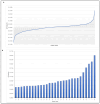Serological Detection of Ovine Gammaherpesvirus 2 Antibodies in Dairy Farms from Southern Brazil
- PMID: 39770831
- PMCID: PMC11676213
- DOI: 10.3390/microorganisms12122629
Serological Detection of Ovine Gammaherpesvirus 2 Antibodies in Dairy Farms from Southern Brazil
Abstract
Sheep-associated malignant catarrhal fever (SA-MCF) is a severe lymphoproliferative vascular disease of cattle that is caused by ovine gammaherpesvirus 2 (OvGHV2), which is a Macavirus within the Gammaherpesvirinae subfamily. SA-MCF occurs worldwide in several mammalian hosts. Alternatively, alcelaphine gammaherpesvirus 1 (AlGHV1) is a Macavirus that causes wildebeest-associated malignant catarrhal fever (MCF), which principally occurs in cattle from Africa. Previous serological assays to evaluate the presence of MCF in mammals used a competitive inhibition enzyme-linked immunosorbent assay (CI-ELISA). This CI-ELISA is based on the 15A antigenic epitope that is common to all Macavirus associated with the development of MCF in their respective hosts. This study evaluated an indirect MCF-specific ELISA assay based on the AlGHV1 C500 strain to detect antibodies against OvGHV2 in 43 closed dairy cattle farms from Southern Brazil. These farms are located in a region where subclinical infections by OvGHV2 have been detected in free-ranging wild boars (Sus scrofa). Sheep or goats were not reared at these farms or within the proximity of these farms. Risk factors associated with seropositivity to OvGHV2 were evaluated, while the possible participation of subclinically infected wild boars in the dissemination of OvGHV2 was estimated using spatial analysis. Sera from 29 dairy cows from 16 farms demonstrated sample/positive (S/P) values considered positive with this MCF-specific ELISA (cutoff S/P, 0.063). The S/P values for the positive dairy cows varied between 0.0633 and 0.2510 (mean, 0.0998; standard deviation, 0.0476). At least one cow was seropositive in 16/43 (37.2%) of these farms, with seropositivity identified in 29/367 (7.9%) of dairy cows maintained at these farms. Additionally, dairy cows raised within the intensive system had a more than threefold higher chance of being seropositive to OvGHV2 relative to those reared within the semi-intensive system. Furthermore, the spatial evaluation revealed that cows on dairy farms within a 50 km radius of the home range of subclinically infected wild boars had an increased risk of being seropositive to this assay. These findings demonstrated that the AlGHV1 C500-specific MCF ELISA can be efficiently used to monitor the occurrence of OvGHV2 in cattle. In addition, the occurrence of subclinically infected free-ranging wild boars within a radius of 50 km from susceptible cattle may be a possible risk factor for the occurrence of OvGHV2-related infections in these animals from Southern Brazil. These initial results are fundamental to understanding the epidemiology of OvGHV2-associated infections and clinical SA-MCF in mammals in Brazil.
Keywords: Macavirus; epidemiology; malignant catarrhal fever; serodiagnosis; spatial analysis; wild boars.
Conflict of interest statement
Author Felippe Danyel Cardoso Martins was employed by the company Veelab Medicina Veterinária Diagnóstica. The remaining authors declare that the research was conducted in the absence of any commercial or financial relationships that could be construed as a potential conflict of interest.
Figures



Similar articles
-
Subclinical Ovine Gammaherpesvirus 2-Related Infections in Free-Ranging Wild Boars (Sus scrofa) from Southern Brazil.Pathogens. 2024 Jun 18;13(6):515. doi: 10.3390/pathogens13060515. Pathogens. 2024. PMID: 38921812 Free PMC article.
-
Transplacental Infections Associated with Macavirus in Aborted Bovine Fetuses.Microorganisms. 2024 Aug 7;12(8):1608. doi: 10.3390/microorganisms12081608. Microorganisms. 2024. PMID: 39203450 Free PMC article.
-
Molecular detection of ovine gammaherpesvirus 2 in free ranging wild boars (Sus scrofa) from Southern Brazil.Braz J Microbiol. 2024 Jun;55(2):1923-1929. doi: 10.1007/s42770-024-01302-4. Epub 2024 Mar 13. Braz J Microbiol. 2024. PMID: 38478359 Free PMC article.
-
A review of the epidemiological, clinical, and pathological aspects of malignant catarrhal fever in Brazil.Braz J Microbiol. 2020 Sep;51(3):1405-1432. doi: 10.1007/s42770-020-00273-6. Epub 2020 Jun 15. Braz J Microbiol. 2020. PMID: 32542424 Free PMC article. Review.
-
Malignant catarrhal fever: inching toward understanding.Annu Rev Anim Biosci. 2014 Feb;2:209-33. doi: 10.1146/annurev-animal-022513-114156. Epub 2013 Oct 18. Annu Rev Anim Biosci. 2014. PMID: 25384141 Review.
References
-
- ICTV International Committee on Taxonomy of Viruses. Subfamily: Gammaherpesvirinae, Genus: Macavirus. [(accessed on 3 March 2024)]. Available online: https://ictv.global/report/chapter/herpesviridae/herpesviridae/macavirus.
-
- Li H., Shen D.T., Knowles D.P., Gorham J.R., Crawford T.B. Competitive inhibition enzyme-linked immunosorbent assay for antibody in sheep and other ruminants to a conserved epitope of malignant catarrhal fever virus. J. Clin. Microbiol. 1994;32:1674–1679. doi: 10.1128/jcm.32.7.1674-1679.1994. - DOI - PMC - PubMed
Grants and funding
LinkOut - more resources
Full Text Sources

